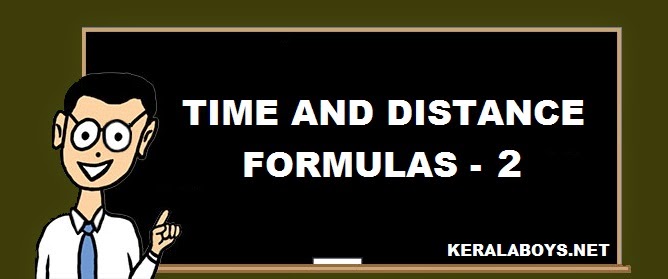
8. In case of speed-distance examples, involving a train, following possibilities exist:
(a) A train is crossing a pole or stationary person
(b) A train is crossing a bridge a tunnel or a river etc.
(c) A train is crossing another train which is
(i) travelling in the direction opposite to the first one or
(ii) travelling in the same direction as the first one
A train is crossing a pole or stationary person : Here, the speed of train and the length of the train are required to be known, in order to determine the time required by the train to cross the pole/standing person. Since a pole has to be stationary and the person is given to be stationary (non-moving), in both the cases, the train is required to travel a distance equal to its own length. Thus the application of the formula distance = speed x time would then give the solution.
A train is crossing another train travelling in the direction opposite to the first one : Here, the speeds of both the trains and the lengths of both the trains are required to be known, in order to determine the time required by the trains to cross each other. The total distance would be the sum of the lengths of both the trains whereas the effective speed of crossing would be the sum of the speeds of both the trains. Thus, it may be noted that even though the speeds of both the trains are given to be equal, the trains would definitely cross each other, if they are travelling in the opposite direction.
A train crossing another train travelling in the same direction as the first one : Here, speeds of both the trains and the lengths of both the trains are required to be known, in order to determine the time required by one of train (moving faster) to cross(overtake) the other train (moving slower). In this case the total distance would be the sum of the lengths of both the trains whereas, the effective speed of crossing (overtake) would be the difference in the speed of the trains. Thus, it may be noted that if the speeds of both the trains are given to be equal, the trains would never cross (overtake) each other, if they are travelling in the same directions.
In case of a "boat" travelling "upstream" (against the current) or "downstream" (along with the current), the speed of the boat (in still water), the speed of the current and the distance travelled are required to be known in order to determine the time required by the boat to travel the distance. In some questions, however, the distance travelled in both the cases (upstream and downstream) remains the same, thereby making it possible to used the following formula :
Where
X = Speed of the boat in still water
Y = Speed of the current
T1 = Time taken by the boat to go downstream
T2 = Time taken by the boat to go upstream
A train is crossing another train travelling in the direction opposite to the first one : Here, the speeds of both the trains and the lengths of both the trains are required to be known, in order to determine the time required by the trains to cross each other. The total distance would be the sum of the lengths of both the trains whereas the effective speed of crossing would be the sum of the speeds of both the trains. Thus, it may be noted that even though the speeds of both the trains are given to be equal, the trains would definitely cross each other, if they are travelling in the opposite direction.
A train crossing another train travelling in the same direction as the first one : Here, speeds of both the trains and the lengths of both the trains are required to be known, in order to determine the time required by one of train (moving faster) to cross(overtake) the other train (moving slower). In this case the total distance would be the sum of the lengths of both the trains whereas, the effective speed of crossing (overtake) would be the difference in the speed of the trains. Thus, it may be noted that if the speeds of both the trains are given to be equal, the trains would never cross (overtake) each other, if they are travelling in the same directions.
In case of a "boat" travelling "upstream" (against the current) or "downstream" (along with the current), the speed of the boat (in still water), the speed of the current and the distance travelled are required to be known in order to determine the time required by the boat to travel the distance. In some questions, however, the distance travelled in both the cases (upstream and downstream) remains the same, thereby making it possible to used the following formula :
| (Downstream) | (Upstream) |
| (X+Y)xT1 | = (X-Y)xT2 |
X = Speed of the boat in still water
Y = Speed of the current
T1 = Time taken by the boat to go downstream
T2 = Time taken by the boat to go upstream
Note that T1 < T2 and Y < X

No comments:
Post a Comment